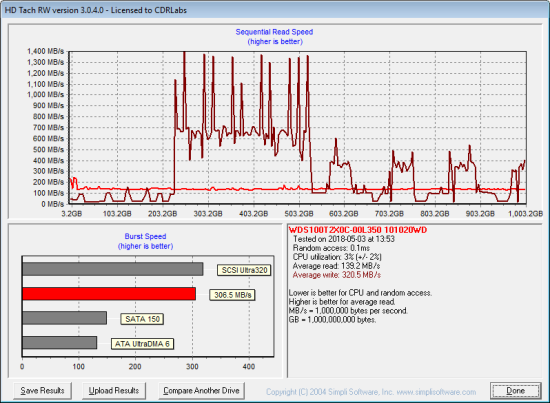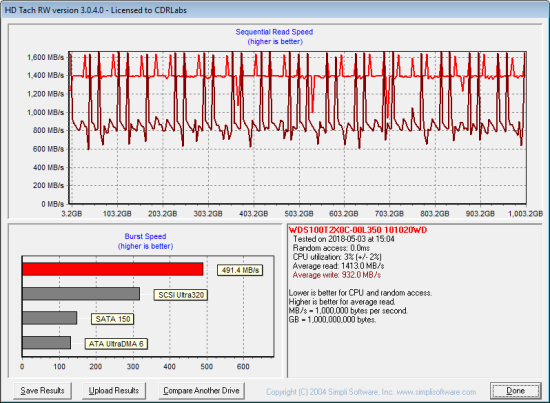TRIM Performance:
While SSDs offer many benefits, there are some downsides to using flash memory. One of the biggest issues people run into is performance degradation. Over time, an SSD will run out of fresh blocks and will have to write over data the file system has marked as deleted. This procedure is very complicated and can slow an SSD's write speeds considerably.
To fix this problem, most manufacturers have added TRIM support to their SSDs. The TRIM command allows an operating system, such as Windows 10, to tell an SSD which data blocks are no longer in use. Using this information, the drive pro-actively erases these blocks and adds them to the free block pool.

To test the WD Black NVMe's TRIM and garbage collection functions, I first put the drive in a "dirty" state. I used Iometer to fill the entire drive and then ran a random write test for 30 minutes. Looking at the screenshot below, you can see that the WD Black NVMe's average read and write speeds dropped to 139.2 MB/s and 320.5 MB/s, respectively.

WD Black NVMe - Dirty
To see how well the WD Black NVMe could recover, I let the computer sit for about 30 minutes and then reran the test. The drive wasn't able to reach the factory fresh performance shown in our earlier tests. However, its average read speed climbed up to 311.4 MB/s.

WD Black NVMe - After TRIM
Unfortunately, the WD Black NVMe does not support the secure erase function so I was not able to wipe the drive with Parted Magic or even Western Digital's own SSD Dashboard software. Instead, I did a quick wipe and format from within Windows. After this, the WD Black NVMe was able to read at 1413.0 MB/s and write at 932.0 MB/s.

WD Black NVMe - Secure Erased
Final Thoughts:
Western Digital has clearly put a lot of time and effort into their new WD Black NVMe SSD. Instead of using an off the shelf solution from Marvell or Silicon Motion, the company engineered their new SSD platform from the ground up. Everything from the WD Black NVMe's Spectrum controller, with its nCache 3.0 tiered caching infrastructure, to the 64-layer BiCS 3D TLC NAND flash has been developed in house. Combine all this with a PCIe Gen3 x4 NVMe 1.3 interface and you have a reasonably priced drive that is capable of delivering the performance that PC gamers are looking for. The 1TB version of the WD Black NVMe flew through our sequential transfer rate tests, reading at speeds as high as 3,469 MB/s and writing at more than 2,861 MB/s. The drive also did very well in our random write tests, producing more than 226,000 IOPS at low queue depths.
The WD Black NVMe is available now in 250GB, 500GB and 1TB capacities. Prices on Amazon.com currently range from $109.99 up to $399.99 for the 1TB version reviewed here.

Highs:
- Available in 256GB, 512GB and 1TB capacities
- PCIe Gen3 x4 NVMe 1.3 interface
- Equipped with 64-layer BiCS3 3D TLC NAND
- Excellent sequential and random read and write speeds
- Features nCache 3.0 technology
- Small M.2 2280 form factor
- Large DRAM cache
- Reasonably priced
- 5 year warranty
Lows:
- Does not support hardware based encryption
- Not available in a 2TB capacity

